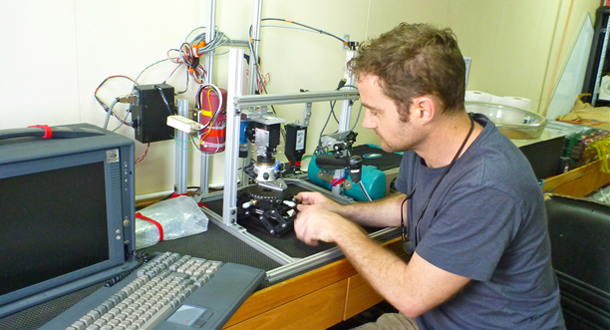Talking with Dr. Kevin Hand

At noon, the survey ship Barakuda is 130 sea miles south of Guam, heading southwest at nine knots. The Mermaid Sapphire is well over the horizon ahead of us. We have 12-knot winds and moderate swells on our stern quarter. Someone mentions that we’re following the same course to the Challenger Deep as Don Walsh and Jacques Piccard just before their 1960 Trieste dive.
As working ships go, the Barakuda is small—120 feet (36 meters) long, 27 feet (8 meters) wide, and just shy of 400 tons. She has two decks: the lower for accommodation, the galley, and mess hall, the upper for the bridge and a narrow, desk-lined workspace. Two ten-foot seagoing containers and lander Mike are lashed to her small, open deck. The space just behind her bridge is a splendid place to have a conversation with a scientist who loves the sea.
“Jim thinks big. He’s fully aware that the systems and techniques used to explore the deepest parts of Earth’s ocean have potential applications in the exploration of oceans on other worlds.”
I’m listening to Dr. Kevin Hand, a planetary scientist and astrobiologist at the Jet Propulsion Laboratory in Pasadena, talk about the scientific studies he’s doing on the Barakuda. Kevin’s work is focused on the origin, evolution, and distribution of life in the solar system and involves experiments in the physics and chemistry of the icy moons in the outer system. He has a special interest in the moon called Europa.
“Europa is the second of Jupiter’s four large moons. Under its thick shell of surface ice we have good evidence for a liquid ocean more than 300,000 feet deep.” He stops and looks out at blue Pacific swells rushing past the bridge windows. “If we’ve learned anything about life on Earth, it’s that liquid water usually means life.”
He ushers me into the small room on the lower deck where he’s fixed his mid-infrared fourier transform spectrometer to a bench. He’ll use its wavelength range of two to twelve microns to study rock and sediment samples recovered by the sub. “I study invisible rainbows,” he says with a smile, “that tell us about the minerals and organic chemistry of the samples. I’m a collector of photons.”
Kevin’s great dream is to be at the launch pad in 2020 when a NASA robotic spacecraft begins its long journey to Europa. It will take about six years for the craft to reach the ice-covered moon and start its orbiting quest for factors that influence habitability. For Kevin, Europa could answer one of humankind’s oldest questions: Is there life beyond Earth?
“There are two primordial questions,” he tells me. “Are we alone? Where did we come from?” All deep-sea science, including what Jim is doing on the DEEPSEA CHALLENGE expedition, edge us a little closer to the answers.
“When Jim comes back to the surface after his seven-mile dive, it will probably be at night. When I see the lights of his sub rising up through the water, I’ll be thinking of some future spacecraft slowly descending to the surface of another world’s ocean.”
Written by Dr. Joe MacInnis
Photograph by Joe MacInnis
More on National Geographic Emerging Explorer Kevin Hand
Kevin Hand, Planetary Scientist/Astrobiologist
Real-World Geography: Dr. Kevin Hand
Looking For Life



